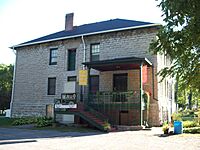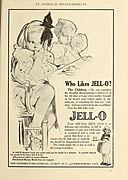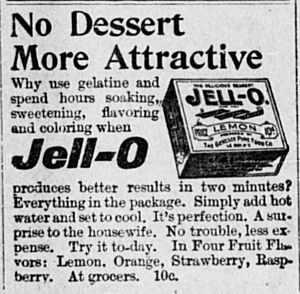Jell-O facts for kids
 |
|
| Owner | Kraft Heinz |
|---|---|
| Introduced | 1897 |
| Type | Gelatin desserts, puddings | ||||||
|---|---|---|---|---|---|---|---|
| Created by | Pearle Bixby Wait | ||||||
| Main ingredients | Powdered gelatin, sugar or artificial sweetener, artificial flavors, food coloring | ||||||
| Variations | Many flavors and various snacks | ||||||
| 80 kcal (335 kJ) [regular], 10 kcal (42 kJ) [sugar-free] | |||||||
|
Jell-O is a famous American brand. It offers many types of powdered desserts. These include fruit-flavored gels, puddings, and no-bake cream pie mixes. The original gelatin dessert is the most well-known product. "Jell-O" is a registered trademark of Kraft Heinz. The company is based in Chicago, Illinois.
This dessert was very popular in the early 1900s. The first gelatin dessert was created in Le Roy, New York, in 1897. Pearle Bixby Wait trademarked the name Jell-O. He and his wife, May, made the product. They added strawberry, raspberry, orange, and lemon flavors to sugar and gelatin. You mix the powder with boiling water, then cool it to make a gel.
Contents
What is Jell-O?
Jell-O is sold in two main ways. You can buy it already made (ready-to-eat). Or you can buy it as a powder. It comes in many different colors and flavors. The powder contains gelatin and flavorings. These include sugar or artificial sweeteners. You dissolve the powder in hot water. Then you chill it until it becomes firm. You can add fruit, vegetables, or whipped cream to make fun snacks. These can be molded into different shapes.
The Jell-O brand also sells pudding and pie-filling mixes. Regular Jell-O pudding is cooked on the stove with milk. You can eat it warm or chilled. Jell-O instant pudding is mixed with cold milk and chilled. It sets without cooking. For pie fillings, you use less liquid with the same pudding mixes.
The History of Jell-O
Early Beginnings of Gelatin Desserts
Gelatin is a protein that comes from collagen. Collagen is found in boiled bones and other animal parts. People have used gelatin in food, especially desserts, since the 1400s.
Gelatin became popular in New York during the Victorian era. People made amazing and detailed jelly molds. Back then, gelatin was sold in sheets. It took a lot of time to clean it. So, gelatin desserts were mostly for rich people. In 1845, Peter Cooper got a patent for powdered gelatin. This powdered gelatin was much easier to make and use in cooking.
In 1897, in LeRoy, New York, Pearle Bixby Wait created a gelatin dessert. He was a carpenter and made cough syrup. He trademarked the name "Jell-O". Wait and his wife, May, added fruit flavors to gelatin and sugar. These flavors were strawberry, raspberry, orange, and lemon. In 1899, Wait sold Jell-O to Orator Francis Woodward. Woodward's Genesee Pure Food Company already made a popular health drink called Grain-O.
Jell-O Becomes Popular
Several things helped Jell-O become a popular product. New technologies like refrigeration and machine packaging played a role. Also, home economics classes taught people how to use it. The company's smart marketing helped a lot too.
At first, Woodward had trouble selling the powdered Jell-O. In 1902, his company started placing advertisements in the Ladies' Home Journal. They called Jell-O "America's Most Famous Dessert." Jell-O was a small success until 1904. That year, the Genesee Pure Food Company sent many salespeople out. They gave away free Jell-O cookbooks. This was a new and very effective marketing idea.
Within ten years, the company added three new flavors. These were chocolate (stopped in 1927), cherry, and peach. They also started selling Jell-O in Canada. Famous people like actress Ethel Barrymore appeared in ads. Recipes and testimonials from them helped promote the brand. Some Jell-O ads were painted by the artist Maxfield Parrish.
In 1923, the Jell-O Company launched "D-Zerta." This was a version of Jell-O with artificial sweetener. Two years later, Postum and Genesee merged. In 1927, Postum bought Clarence Birdseye's frozen foods company. This created the General Foods Corporation.
By 1930, congealed salads became very trendy in American cooking. The company then introduced lime-flavored Jell-O. This flavor was perfect for the many ingredients people were adding to these salads. Popular Jell-O recipes often included things like cabbage, celery, and even cooked pasta.
In 1934, Jell-O sponsored comedian Jack Benny. He became the dessert's spokesperson. Around this time, a famous jingle was introduced. It spelled out "J-E-L-L-O" with a rising musical tune. This jingle was well-known for many decades. Don Bestor, the bandleader on Jack Benny's radio show, wrote the jingle.
In 1936, chocolate Jell-O returned. It was an instant pudding made with milk. It became very popular. Over time, other pudding flavors were added. These included vanilla, tapioca, coconut, pistachio, and butterscotch.
By the 1950s, salads were so popular that Jell-O made savory flavors. These included celery, Italian, mixed vegetable, and seasoned tomato. These flavors are no longer sold today.
Jell-O and the Baby Boom Era
Between the 1920s and 1950s, many fancy tea time foods were popular. Jell-O became an affordable ingredient for making delicate dishes. By the 1920s, almost one-third of salad recipes in cookbooks used gelatin. These often had fruit, vegetables, or even cream cheese.
Old recipes from the early 1900s included fruits like figs, dates, and bananas. Lemon Jell-O was often paired with maraschino cherries, marshmallows, and almonds. One sweet gelatin dessert was called "Good Salad." It had vanilla pudding, tapioca pudding, pineapple, mandarin oranges, and orange gelatin.
The "baby boom" after World War II led to a big increase in Jell-O sales. Young mothers often didn't have as much help as older generations. So, companies promoted easy-to-prepare foods. By this time, making a Jell-O dessert was simple. You just boiled water, mixed it with Jell-O, and put it in Tupperware molds to chill.
New flavors were always being added, and unpopular ones were removed. In the 1950s and 1960s, flavors like apple, black cherry, grape, and lemon-lime appeared. In 1966, the Jell-O "No-Bake" dessert line started. This allowed people to make a cheesecake in just 15 minutes. In 1969, Jell-O 1•2•3 was introduced. This gelatin dessert separated into three layers as it cooled. It was common until 1987 but is rare now. In 1971, ready-to-eat pudding cups called Jell-O Pudding Treats were launched.
Sales Changes and Comeback
In 1964, the slogan "There's always room for Jell-O" was introduced. It promoted Jell-O as a "light dessert" that could be eaten even after a big meal.
From the 1960s to the 1980s, Jell-O's sales slowly went down. Many Jell-O dishes became special occasion foods instead of everyday items. Marketers thought this happened because families were smaller. Also, people had faster lifestyles, and more women were working. By 1986, a study showed that mothers with young children rarely bought Jell-O.
To fix this, Jell-O hired Dana Gioia. The marketing team looked at old Jell-O cookbooks. They rediscovered "Jigglers," though they weren't called that originally. Jigglers are Jell-O snacks molded into fun shapes. They are eaten as finger food. Jell-O started a huge marketing campaign. Bill Cosby became the spokesperson. This campaign was a big success and greatly increased sales.
Cosby became the brand's spokesperson in 1974. He continued to be the voice of Jell-O for almost thirty years. During his time, he helped introduce new products. These included frozen Jell-O Pops and Sugar-Free Jell-O. Sugar-Free Jell-O replaced D-Zerta in 1984. It was sweetened with NutraSweet. He also promoted Jell-O Jigglers and Sparkling Jell-O. In 2010, Cosby returned as a Jell-O spokesperson in an online series called OBKB.
In 1990, General Foods merged into Kraft Foods Inc.. New flavors were introduced. These included watermelon, blueberry, cranberry, margarita, and piña colada. In 2001, the state Senate of Utah recognized Jell-O as a favorite snack food. They noted its importance in Mormon cuisine. Governor Michael O. Leavitt declared an annual "Jell-O Week." During the 2002 Winter Olympics in Salt Lake City, souvenir pins included one with green Jell-O.

As of 2011, over 420 million boxes of Jell-O gelatin were sold each year in the United States. Also, over 1 billion Jell-O cups were sold. As of 2016, there were more than 110 products under the Jell-O brand name.
Jell-O is often used to make "Jell-O molds." These use a mold designed for gelatin. You can add chopped fruit, nuts, and other ingredients before it hardens. Fresh pineapple, papaya, kiwifruit, and ginger root cannot be used. They contain enzymes that stop gelatin from "setting."
Manufacturing and Museums

As of 2012, LeRoy, New York, is known as the home of Jell-O. It has the only Jell-O Museum in the world. The museum is on the main road through the small town. Jell-O was made here until 1964. That's when General Foods closed the plant. Manufacturing moved to Dover, Delaware. The Jell-O Gallery museum is run by the Le Roy Historical Society. It is located at the Le Roy House and Union Free School.
At the museum, visitors can learn about the dessert's history. Visitors can follow "Jell-O Brick Road." Its stones have the names of former factory employees. The museum shows starting materials for Jell-O. It also displays various molds.
The Jell-O plant (Kraft Heinz) in Mason City, Iowa, makes America's supply of ready-to-eat Jell-O gelatin dessert and pudding cups.
Advertising Campaigns
Jell-O's first advertising campaign started in 1904. It appeared in the Ladies' Home Journal. The print ads often included recipes and colorful pictures. They became very popular. Famous artists like Rose O'Neill, Maxfield Parrish, and Norman Rockwell worked on the campaign. Franklin King, an artist for the Dauchy Company, used his daughter Elizabeth in many pictures. She became the well-known "Jell-O Girl."
Jack Benny's popular radio program began its Jell-O sponsorship in 1934. The show did not have commercial breaks. Instead, announcer Don Wilson talked about Jell-O during the program. This often made Jack comically annoyed. The first show introduced the five-note "J-E-L-L-O!" jingle. This jingle was used in Jell-O's ads for many years. Lucille Ball's My Favorite Husband radio show was also sponsored by Jell-O. Her character often greeted listeners with "Jell-O, everybody!"
Comedian Bill Cosby was closely linked with Jell-O. He appeared in many commercials for Jell-O and Jell-O pudding. Later shows like Mad TV, The Simpsons, and Saturday Night Live made fun of Cosby using Jell-O references. In the 1960s, the cast of Hogan's Heroes did a commercial with Carol Channing for Jell-O. Also, in the early seasons of Lucille Ball's 1960s TV series, The Lucy Show, cast members often did commercials for Jell-O.
In 1995, Jell-O used the tagline "It's alive!" and the phrase "J-E-L-L-OOOOOOO!".
In August 2018, Jell-O released an animated series called "JELL-O Wobz." It was on YouTube and Amazon Prime Video. They partnered with DreamWorksTV for this.
In 2023, Jell-O updated its brand design. It was the first time in ten years. The new design is more playful. The logo became bolder and blockier. It also featured very realistic pictures of pudding and jelly fruit.
In September 2024, Jell-O launched "The Jelly Collection." This is a series of inflatable furniture. It was inspired by the famous Jell-O molds.
Jell-O in Culture
Jell-O is mentioned in the 1936 song "A Fine Romance." The song humorously calls it a boring alternative to exciting love. In 1980, composer William Bolcom wrote a funny song about Jell-O. It was called "Lime Jello Marshmallow Cottage Cheese Surprise." This song made fun of how Jell-O was used in strange sweet and savory dishes.
In 1992, Ivette Bassa won an Ig Nobel Prize in chemistry. She won for inventing blue Jell-O.
The rock group Green Jellÿ was first named Green Jellö. They had to change their name. This was because Kraft Foods said the band was using the Jell-O trademark without permission.
Jell-O and Mormon Culture
Jell-O is very popular among Mormons. So much so that the Mormon Corridor region is sometimes called the Jell-O Belt. In 2001, the Utah Senate recognized Jell-O as "a favorite snack food of Utah." They noted that Utah had eaten the most Jell-O per person for many years. They also mentioned how Utah citizens rallied to "Take Back the Title." This happened after Des Moines, Iowa, ate more Jell-O than Utah in 1999. The culture of Utah and efforts by students at Brigham Young University were also reasons for recognizing Jell-O. Bill Cosby, the Jell-O spokesperson, spoke to the Utah Legislature. He said he believed people in Utah loved Jell-O because it was perfect for families. He noted that people in Utah are very family-focused.
The idea that Mormons love Jell-O is not very old. News reports from 1969 and 1988 about popular foods in Utah did not mention Jell-O. A 1988 article even said Jell-O was a Lutheran tradition. In the late 1980s, Jell-O had a marketing campaign. It promoted the snack and its Jigglers recipe as fun for kids and easy for parents. This message worked well with family-focused Mormons. In 1997, Kraft shared sales figures. They showed that Salt Lake City had the highest Jell-O consumption per person.
Current Jell-O Flavors
The following are the flavors of Jell-O products made today:
Gelatin Flavors
- Apricot
- Berry Blue
- Black Cherry
- Blueberry Pomegranate
- Cherry
- Cherry Lemonade
- Cranberry
- Fruit Punch
- Grape
- Jolly Rancher Sour Green Apple
- Lemon
- Lime
- Mango
- Margarita
- Melon Fusion
- Mixchief Grape Color-Changing
- Mixchief Juice
- Mixchief Soda Pop
- Orange
- Peach
- Piña Colada
- Pineapple
- Raspberry
- Strawberry
- Strawberry Daiquiri
- Strawberry-Banana
- Tropical Fusion
- Watermelon
Pudding Flavors
- Banana Cream
- Boston Cream Pie
- Butterscotch
- Candy Cane
- Caramel
- Cheesecake
- Chocolate
- Chocolate Fudge
- Chocolate-Vanilla Swirl
- Classic Turtle
- Coconut Cream
- Crème brûlée
- Custard
- Dark Chocolate
- Devil's Food
- Double Chocolate
- Dulce De Leche
- Flan
- French Vanilla
- Gingerbread
- Lemon
- Mixchief Vanilla Color-Changing
- Orange Ice Cream
- Oreo Cookies 'n Creme
- Pistachio
- Pumpkin Spice
- Red Velvet
- Rice Pudding
- S'more pudding
- Strawberry Cheesecake
- Strawberry Crème
- Strawberry Ice Cream
- Tapioca
- Vanilla
- White Chocolate
Also available in a sugar free/low calorie product.
Available seasonally.
Only available as a prepared product.
See Also
- Aeroplane Jelly
- Aspic
- Jell-O Museum
- Jello Biafra
- Jello salad
- Green Jellö









